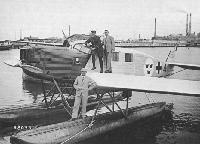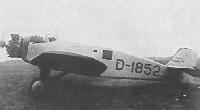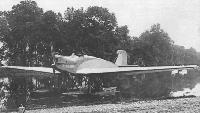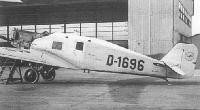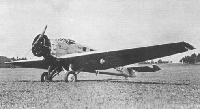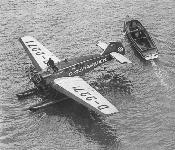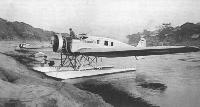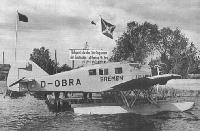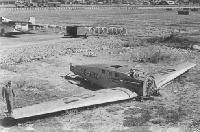Фотографии
-
Регистрационный номер: D-1167 The W 33 D-1167 Bremen which made the first east-west aeroplane crossing of the North Atlantic. It was given upturned wingtips before the flight.
THE GERMAN ATLANTIC FLIGHT: Three-quarter front view of the Junkers W.33 monoplane "Bremen," with 280-310 h.p. Junkers L.5 engine, in which Capt. Koehl, Baron von Huenefeld and Commandant Fitzmaurice flew from Baldonnel to Greenly Island, off Labrador.Самолёты на фотографии: Junkers W 33 / W 34 / Ju.46 - Германия - 1926
-
Регистрационный номер: D-2418 Luft Hansa’s W 34hi D-2418 Merkur, with BMW Hornet engine.
Самолёты на фотографии: Junkers W 33 / W 34 / Ju.46 - Германия - 1926
-
Swedish Air Force W 34 ambulance with wooden propeller and enclosed cockpit.
Самолёты на фотографии: Junkers W 33 / W 34 / Ju.46 - Германия - 1926
-
Регистрационный номер: CF-AQW Canadian Airways' W34 CF-AQW, c/n/2587, at a Hudson's Bay Company trading post.
Самолёты на фотографии: Junkers W 33 / W 34 / Ju.46 - Германия - 1926
-
Регистрационный номер: D-1642 W 33c D-1642 demonstrating crop spraying.
Самолёты на фотографии: Junkers W 33 / W 34 / Ju.46 - Германия - 1926
-
Unidentified Swedish W 33g ambulance floatplane.
Самолёты на фотографии: Junkers W 33 / W 34 / Ju.46 - Германия - 1926
-
Регистрационный номер: D-1852 The Armstrong Siddeley Panther-powered W 34fy D-1852.
Самолёты на фотографии: Junkers W 33 / W 34 / Ju.46 - Германия - 1926
-
Регистрационный номер: D-921 D-921, the prototype Junkers W 33, was converted from an F 13.
Самолёты на фотографии: Junkers W 33 / W 34 / Ju.46 - Германия - 1926
-
Регистрационный номер: D-1696 Luft Hansa’s W 33c D-1696 Taurus. The dark rectangle on the fuselage, forward of the door, is a panel on the base of which are the words London-Berlin.
Самолёты на фотографии: Junkers W 33 / W 34 / Ju.46 - Германия - 1926
-
Регистрационный номер: SE-ABZ [2] AB Aerotransport's W 33 SE-ABZ after being fitted with a Pratt & Whitney Wasp engine, making it one of the few radial-engined W 33s.
Самолёты на фотографии: Junkers W 33 / W 34 / Ju.46 - Германия - 1926
-
Регистрационный номер: D-2271 [2] The Ju 46fi D-2271 Bremen at Woolston, Southampton, on September 22, 1933, after being forced down off the Isle of Wight.
LOST AND FOUND: After being catapulted from the German liner Bremen, with mails from America, at 11.30 a.m. on September 21, Herr Gruetering, the pilot (together with a mechanic and wireless operator) was due at Southampton by 7 p.m. He failed to arrive, and a wireless message being received from the pilot stating he was running short of fuel (having lost his bearings), ships and aircraft were sent out to make a search, but without success. Gruetering meanwhile had landed alongside a French trawler, off Ushant, which took him in tow towards England. Early next morning the Junkers seaplane was able to take off and fly to Southampton, where it arrived, as depicted in our illustration, shortly after noon.Самолёты на фотографии: Junkers W 33 / W 34 / Ju.46 - Германия - 1926
-
Регистрационный номер: D-2271 [2] Lufthansa’s Ju 46fi D-2271 in a silver paint scheme as the landplane Hamburg.
Самолёты на фотографии: Junkers W 33 / W 34 / Ju.46 - Германия - 1926
-
Регистрационный номер: D-922 The prototype Junkers W 34. The circular roof hatch is just visible.
Самолёты на фотографии: Junkers W 33 / W 34 / Ju.46 - Германия - 1926
-
SCADTA’s W 34 floatplane Cundinamarca on the Magdalena river. A second W 34 is in the background.
Самолёты на фотографии: Junkers W 33 / W 34 / Ju.46 - Германия - 1926
-
Регистрационный номер: D-OBRA, D-2491, D-UHYL Lufthansa’s Ju 46hi D-OBRA Bremen when operating German domestic services. It had been the North Atlantic seaplane D-UHYL Bremen and before that the landplane D-2491 Sirius.
Самолёты на фотографии: Junkers W 33 / W 34 / Ju.46 - Германия - 1926
-
Регистрационный номер: SE-ABZ [2] AB Aerotransport's W33 SE-ABZ at Bromma Airport, Stockholm, in August 1946.
Самолёты на фотографии: Junkers W 33 / W 34 / Ju.46 - Германия - 1926
-
Регистрационный номер: LN-DAB KEITH WOODCOCK'S colour painting shows DNL (Norwegian Air Lines) Swedish-built Junkers W 34 LN-DAB Ternen.
Самолёты на фотографии: Junkers W 33 / W 34 / Ju.46 - Германия - 1926
Статьи
- -
- Aeronca C-3 G-AEFT /Preservation Profile/
- Personal album
- ??? - Forties Favourites (3)
- A.Lumsden, T.Heffernan - Per Mare Probare (4)
- J.Meadows - The Auxiliary Tradition (4)
- J.Stroud - Wings of Peace
- M.Hardy - 1950 RAF Display (1)
- M.Jerram - For Business and Pleasure
- M.Oakey - Grapevine
- R.Cockburn - Reef Encounter
- R.Havercroft - Armament Flight (2)
- R.Nicholls - Surplus to Requirements (2)





